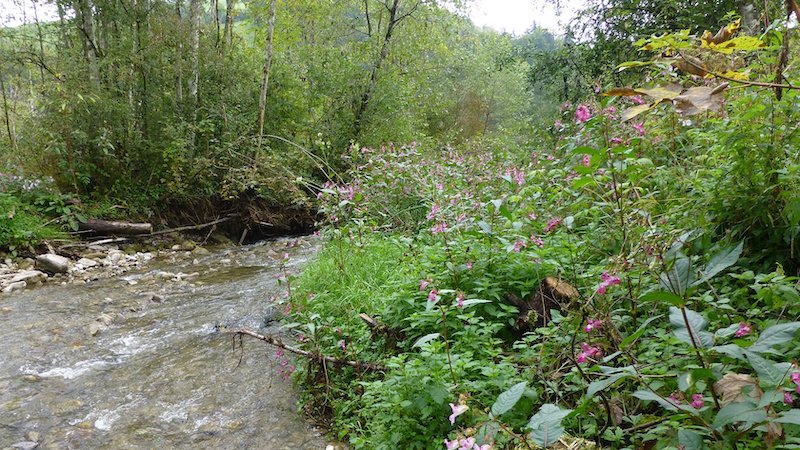Impacts Of Invasive Species Transcend Ecosystem Boundaries
Impacts Of Invasive Species Transcend Ecosystem Boundaries Eurasia Review


Invasive Species and Their Cross-Ecosystem Impacts

Invasive species are widespread around the world and have a profound impact on the ecosystem they invade. They are therefore considered to be one of the five most important threats to global biodiversity and ecosystems. However, in a study just published in the journal “Nature Ecology & Evolution”, two researchers from the aquatic research institute Eawag have now shown for the first time that their impact frequently extends beyond the boundaries of the invaded ecosystem.
Postdoctoral researcher Tianna Peller and Florian Altermatt, group leader at Eawag and professor of aquatic ecology at the University of Zurich, have compiled examples of the cross-ecosystem impacts of invasive species worldwide for the first time in a global overview. From this, they have gained insights that shed new light on the extent of the ecological threat posed by invasive species.
“Our work shows that the impact of invasive species across ecosystem boundaries is a ubiquitous phenomenon,” explains Tianna Peller, “leading to changes in biodiversity and ecosystem functions around the world.” A holistic management of invasive species is therefore necessary, the researchers conclude.
Three Main Pathways for Cross-Ecosystem Impacts
Interactions between ecosystems are widespread in nature and connect, for example, forests and lakes, grasslands and rivers as well as coral reefs and the deep ocean. In their work, the researchers show that invasive species influence these interactions in three different ways. Firstly, they can change the amount of organisms and materials that flow across ecosystem boundaries. Secondly, they can change the quality of these flows, which may, for example, influence how valuable they are for the animals that consume them as food. And thirdly, invasive species can cause new spatial flows between ecosystems that did not exist before the invasion of the species, for example through secondary plant substances produced by invasive terrestrial plants, which flow into aquatic ecosystems.
“As a result, invasive species can have ecological impacts that extend up to 100 kilometres beyond the ecosystem they invade,” explain the authors of the study. “While we often categorise invasive species as aquatic or terrestrial, our results suggest that the impacts of invasive species often transcend the aquatic-terrestrial interface.”
Predatory Invaders in the Chagos Archipelago
How invasive species disrupt spatial processes and set in motion a whole cascade of effects on other ecosystems is well illustrated by the example of rats (Rattus spp.), which were introduced to islands in the Chagos Archipelago in the Indian Ocean. The predatory invaders have significantly reduced the bird populations on the islands. Fewer birds means less bird droppings, which has disrupted the flow of nitrogen from the islands to the coral reefs. This in turn has had an impact on the fish in the reefs, whose biomass has decreased by up to 50 per cent. Critical ecosystem functions performed by the fish, such as grazing and bioerosion, have thus been drastically affected.
From the Himalayas to Switzerland
An example from Switzerland shows how invasive species can introduce new spatial flows between ecosystems. The invasion of the Himalayan balsam (Impatiens glandulifera), originally native to the Himalayas, has led to the secondary plant substances produced by this species being leached into neighbouring aquatic ecosystems and impacting growth and reproductive rates of aquatic organisms.
Predatory Lake Trout in the USA
The invasive lake trout (Salvelinus namaycush) in the USA is another impressive example of the spatially cascading effects an invasive species can trigger. This invasive species voraciously eats the native Yellowstone cutthroat trout, which has interrupted their migration from lakes to rivers. This affects nutrient cycles and food webs in the rivers, but also on land (see graphic).
Impacts on the Management of Ecosystems
Overall, the study emphasises the importance of considering the broader spatial context when assessing the ecological impacts of invasive species. In particular, it shows that non-native species should not only be considered within conventional ecosystem compartments such as marine, terrestrial or freshwater, but that their management requires a more holistic perspective. “By understanding how invasive species affect exchanges between ecosystems, management efforts can be better targeted to mitigate their effects,” says Florian Altermatt.
SDGs, Targets, and Indicators
-
SDG 15: Life on Land
- Target 15.8: By 2020, introduce measures to prevent the introduction and significantly reduce the impact of invasive alien species on land and water ecosystems and control or eradicate the priority species.
- Indicator 15.8.1: Proportion of countries adopting relevant national legislation and adequately resourcing the prevention or control of invasive alien species.
-
SDG 14: Life Below Water
- Target 14.1: By 2025, prevent and significantly reduce marine pollution of all kinds, in particular from land-based activities, including marine debris and nutrient pollution.
- Indicator 14.1.1: Index of coastal eutrophication and floating plastic debris density.
Analysis
The article discusses the cross-ecosystem impacts of invasive species, highlighting their profound impact on biodiversity and ecosystems. Based on this information, we can identify the following SDGs, targets, and indicators:
1. SDG 15: Life on Land
The issue of invasive species aligns with SDG 15, which focuses on protecting, restoring, and promoting sustainable use of terrestrial ecosystems. Invasive species are considered a threat to global biodiversity and ecosystems.
Targets:
- Target 15.8: By 2020, introduce measures to prevent the introduction and significantly reduce the impact of invasive alien species on land and water ecosystems and control or eradicate the priority species.
Indicators:
- Indicator 15.8.1: Proportion of countries adopting relevant national legislation and adequately resourcing the prevention or control of invasive alien species.
2. SDG 14: Life Below Water
The article also highlights the impact of invasive species on marine ecosystems, connecting to SDG 14, which focuses on conserving and sustainably using the oceans, seas, and marine resources.
Targets:
- Target 14.1: By 2025, prevent and significantly reduce marine pollution of all kinds, in particular from land-based activities, including marine debris and nutrient pollution.
Indicators:
- Indicator 14.1.1: Index of coastal eutrophication and floating plastic debris density.
Table: SDGs, Targets, and Indicators
| SDGs | Targets | Indicators |
|---|---|---|
| SDG 15: Life on Land | Target 15.8: By 2020, introduce measures to prevent the introduction and significantly reduce the impact of invasive alien species on land and water ecosystems and control or eradicate the priority species. | Indicator 15.8.1: Proportion of countries adopting relevant national legislation and adequately resourcing the prevention or control of invasive alien species. |
| SDG 14: Life Below Water | Target 14.1: By 2025, prevent and significantly reduce marine pollution of all kinds, in particular from land-based activities, including marine debris and nutrient pollution. | Indicator 14.1.1: Index of coastal eutrophication and floating plastic debris density. |
Behold! This splendid article springs forth from the wellspring of knowledge, shaped by a wondrous proprietary AI technology that delved into a vast ocean of data, illuminating the path towards the Sustainable Development Goals. Remember that all rights are reserved by SDG Investors LLC, empowering us to champion progress together.
Source: eurasiareview.com

Join us, as fellow seekers of change, on a transformative journey at https://sdgtalks.ai/welcome, where you can become a member and actively contribute to shaping a brighter future.







